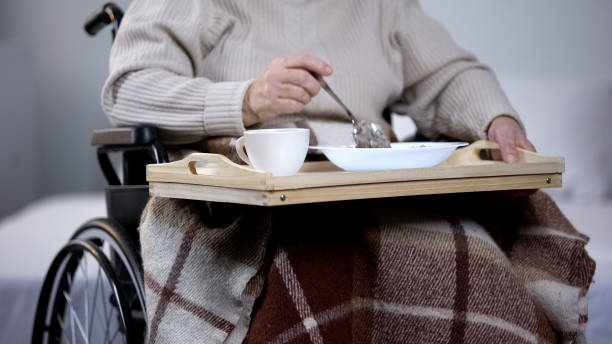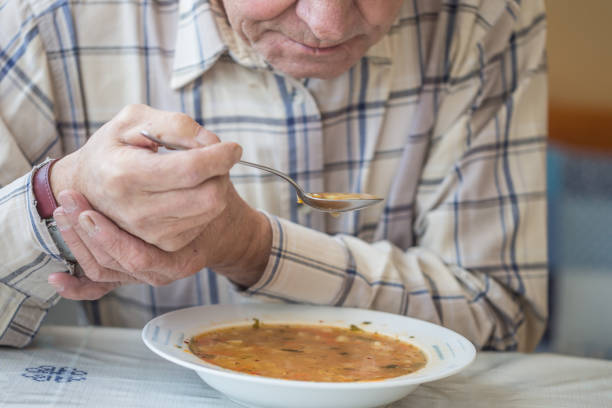Introduction

Eating can be challenging for individuals living with Parkinson's disease, especially when tremors make it difficult to maintain control over utensils. However, the right utensils can significantly improve independence and confidence during mealtimes. In this blog post, you will find information about utensils designed to help individuals with tremors associated with Parkinson's disease.
From adaptive spoons to weighted forks, these innovative tools are carefully crafted to enhance stability and make dining a more enjoyable experience. Discover how these utensils can help alleviate the challenges associated with Parkinson's tremors and regain control at the table.
Factors to consider when choosing utensils for Parkinson's tremors

When selecting utensils for eating with Parkinson's tremors, several important factors must be considered. The right type of utensil can make meal times more manageable and enjoyable, even when dealing with the effects of tremors.
When choosing utensils for tremors, consider the following important factors:
Stability and grip
Stability and grip are two of the most important considerations when choosing utensils for Parkinson's tremors. Utensils that offer stability will help reduce tremors while eating and provide a comfortable grip. Look for utensils with large handles that provide plenty of surface area to maintain a good grip. Handles should be made of easy-to-grip materials such as silicone or rubber to provide a secure hold. Weighted utensils with heavier handles can also help improve stability, reducing the effort required to keep the utensil steady while eating.
Utensils designed specifically for individuals with Parkinson's should also have an ergonomic design for improved comfort and control. The handle should provide ample cushioning to reduce hand fatigue and have a non-slip grip. Specialized utensils with built-in stabilizing rings or weighted handles can help to further reduce tremors while eating.
For extra stability and grip, consider using one or two-handed utensils. These larger utensils provide extra support and stability while allowing both hands to securely hold the handle for improved control. Utensils with large, extended handles are also great options as they provide more surface area to help maintain a better grip.
Finally, suction cup utensils can be an ideal solution for individuals with Parkinson's tremors. Suction cup utensils are designed to attach to the table or plate, providing extra stability when eating. The suction cups also provide a secure grip, reducing the risk of dropping the utensil while eating.
Weight and balance
When selecting utensils for Parkinson's tremors, the weight and balance of the utensil is another important factor to consider. Utensils that are too light or top-heavy can be difficult to hold and manipulate, resulting in fatigue and increased shaking. On the other hand, utensils that are too heavy can be difficult to control and cause unnecessary strain.
Ideally, look for utensils that are well-balanced and moderately weighted. The handle should have an even weight distribution and be lightweight and sturdy. This helps to reduce fatigue while providing sufficient stability and control. Utensils with adjustable weights are ideal as they can be easily adjusted to meet the user's individual needs and preferences.
For extra support and control, consider selecting utensils with weighted handles. These utensils have an additional weight built into the handle, which helps reduce tremors while eating. In addition, these utensils are often designed with ergonomic handles that provide extra cushioning and support, reducing hand fatigue.
One-handed utensils can also be beneficial for individuals with Parkinson's tremors. These larger utensils provide more support and stability when eating while allowing both hands to securely hold the handle for improved control. Many one-handed utensils are also designed with weighted handles to reduce eating tremors.
Finally, suction cup utensils can be a great solution for individuals with Parkinson's tremors as they attach to the table or plate, providing extra stability when eating. Suction cup utensils come in various sizes and weights, making them ideal for individuals who need extra support while eating.
By considering weight and balance when selecting utensils for Parkinson's tremors, individuals can find the perfect solution that combines stability, comfort, and control. Utensils that provide ample cushioning and support and adjustable weights are ideal for reducing tremors and hand fatigue, creating a more pleasant mealtime experience. With the right utensils, individuals with Parkinson's can enjoy eating more easily and confidently.
Customizable Features
When selecting utensils for Parkinson's tremors, another important factor to consider is the customizable features. Utensils that can be adjusted or customized to meet individual needs provide extra comfort and support.
For instance, adjustable weight utensils are a great option as they allow users to customize the weight of the utensil based on their individual needs. The user can select a comfortable and easy weight to handle, which can decrease fatigue and shake during meals.
Utensils with adjustable handles are also great for individuals with Parkinson's tremors. These utensils can be adjusted to provide extra cushioning and support along the handle, helping to reduce tremors while eating. Adjustable handles also allow users to choose a handle length that is comfortable and easy to hold, improving control and stability while eating.
In addition, many utensils come with additional customizable features such as non-slip surfaces or ergonomic grips. These features help to keep the utensil firmly in the user's hand, reducing tremors and providing a more secure grip. Non-slip surfaces can also help prevent food from slipping off the utensil, making eating easier and less stressful.
Finally, look for utensils that are easy to clean and maintain. Utensils with removable parts or replaceable heads can be a great option as they are easier to clean and maintain. Utensils with removable parts also provide extra versatility, allowing users to mix and match utensils for different tasks or meals.
By looking for customizable features, individuals with Parkinson's tremors can find the perfect solution that meets their individual needs. Utensils with adjustable weights, handles, grips, and removable parts provide comfort and support while allowing users to easily control the utensil. With the right utensils, individuals can enjoy eating with less fatigue and tremors, creating a more pleasant mealtime experience.
Cutlery Sets
When choosing utensils for individuals with Parkinson's tremors, cutlery sets are a great option. Cutlery sets are available in various sizes and styles to meet individual needs, providing extra control and stability when eating.
For instance, many cutlery sets come with weighted handles, helping users to better control the utensil. Weighted handles help to reduce tremors and provide extra stability while eating, creating a more pleasant mealtime experience.
In addition, many cutlery sets come with adjustable features that allow users to customize the weight and balance of the utensil. Adjustable weights can help users to find the perfect balance between comfort and control, reducing fatigue and tremors while eating.
Furthermore, many cutlery sets have features such as non-slip surfaces or ergonomic grips. These features help to keep the utensil firmly in the user's hand, providing extra control and stability while eating. Non-slip surfaces can also help reduce the risk of food slipping off the utensil, creating a more pleasant mealtime experience.
Finally, many cutlery sets are designed with easy cleaning and maintenance in mind. Utensils with removable parts or replaceable heads are easier to clean and maintain, providing extra convenience and versatility.
What is the best spoon for Parkinson's disease?

People with Parkinson's disease often experience tremors, making everyday tasks like eating difficult. The right utensils can make a big difference in helping you eat more easily and comfortably. Here are some of the best spoons for people living with Parkinson's disease:
-
A weighted spoon has a thicker handle that helps you hold it more securely and provides greater control. Some of these spoons also have a non-slip grip for added stability.
-
A spoon with a built-up handle has a bigger handle that makes it easier to hold with one hand. "This can help improve your spoon control while eating."
-
An angled spoon is specifically designed to be held in one hand, and the angle of the handle allows you to scoop up food more easily.
-
An eating utensil called an adaptive utensil can be customized based on your requirements. It has an ergonomic handle provides a comfortable grip and adjustable positioning for optimal control while eating.
What helps Parkinson's patients to eat?
Good nutrition is essential for people with Parkinson's disease, as it can help them maintain their nutritional status and meet their energy needs. Eating can become a challenge for many Parkinson's patients due to changes in appetite, difficulty with chewing and swallowing, fatigue, depression, and medication side effects.
To ensure that Parkinson's patients receive proper nutrition, they must recognize their specific eating challenges. People with Parkinson's may benefit from making easy modifications to their daily routine and diet in order:
-
Consuming various foods from all food groups is important, including lean protein sources, fruits, and vegetables.
-
Make meals interesting by adding seasonings, sauces, and garnishes
-
To keep your energy levels up, spread smaller meals throughout the day.
-
Include high-calorie snacks or drinks like smoothies and shakes for quick nutrition on the go
-
Drink plenty of fluids to stay hydrated
-
Use utensils with non-slip handles for better grip and comfort
-
Taking the medication at least 30 minutes before meals is recommended to improve digestion.
-
Exercise regularly to improve appetite and digestion
-
Seek help from a dietitian to evaluate the nutritional needs of the individual.
FAQ's
What juice is good for Parkinson's?
Fruit and vegetable juices benefit people with Parkinson's, providing essential vitamins and minerals. Some of the best juices for Parkinson's patients include freshly-squeezed lemon juice, apple juice, carrot juice, beetroot juice, spinach juice, and wheatgrass juice. These juices can help boost energy levels and improve overall health. Many of these juices also contain antioxidants that can help reduce inflammation and protect against cellular damage.
What cutlery is best for Parkinson's patients?
Cutlery with a non-slip handle is the best option for Parkinson's patients, as this helps to ensure better grip and control. Utensils with weighted handles are also beneficial, providing added stability while eating. Adaptive cutlery can be adjusted according to individual needs and provide an ergonomic handle for added comfort.
Do weighted utensils help with tremors?
Weighted utensils can help to reduce the effects of tremors and provide better control while eating. The added weight helps to reduce the amount of movement caused by the tremor, making it easier to hold and maneuver the spoon or fork. Additionally, many weighted utensils come with non-slip handles for added stability.
What fruit helps Parkinson's disease?
Fruits are a great source of essential vitamins and minerals that can help to boost energy levels and improve overall health. Fruits like apples, oranges, bananas, blueberries, strawberries, cherries, grapes, papayas, and pineapples are high in antioxidants that can help reduce inflammation and protect against cellular damage.
What helps with Parkinson's tremors naturally?
Regular exercises, such as walking and stretching, can help to reduce tremors. Additionally, practices like yoga and tai chi benefit Parkinson's patients. Dietary changes can also help, such as increasing the intake of omega-3 fatty acids found in fish oil and avoiding caffeine and alcohol.
Conclusion
I hope this article has provided helpful information about the best utensils for eating with Parkinson's disease tremors. Eating can be challenging for those living with Parkinson's, but it doesn't have to be. By making small modifications and using specialized utensils, people with Parkinson's can ensure they receive the nutrients their bodies need. Additionally, eating a balanced diet and staying hydrated can help to maintain energy levels and overall health. Finally, regular exercise and stress management can help reduce tremors' effects. With these tips in mind, you can be sure you are doing everything possible to make mealtime easy for yourself or your loved one.

